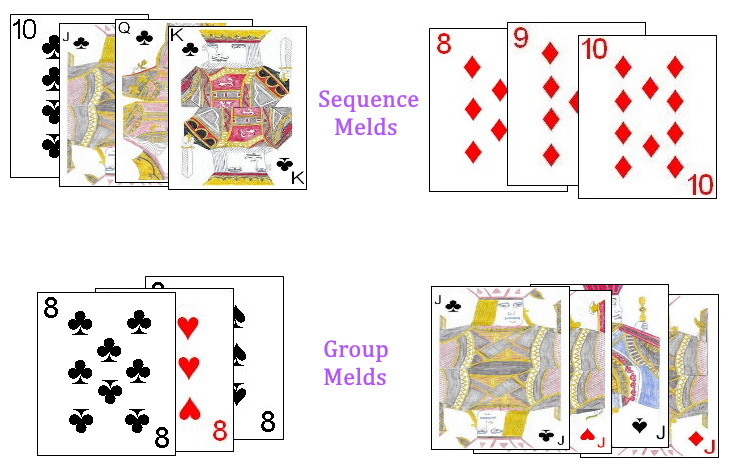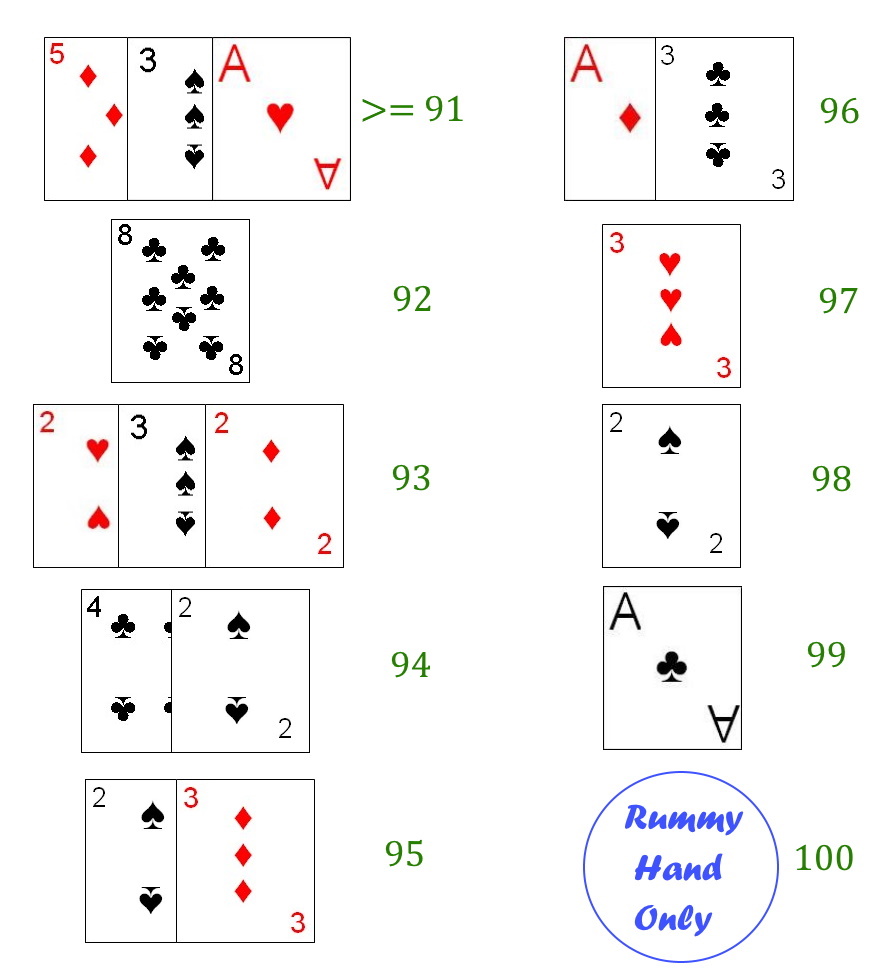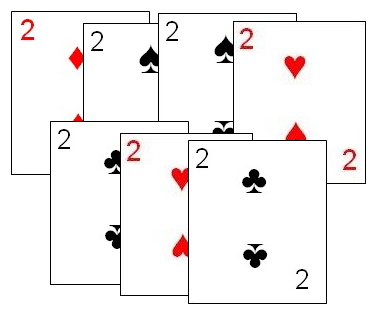One Hundred and One Rummy is a Rummy derivative which appears to be most closely related to Knock Rummy, but has several features which make it a unique game. This game appeared to have been most popular in the United States in the 1950's.
One Hundred and One Rummy is designed for play by 2 to 6 players, using one standard 52 card deck. The ranking of the cards in this deck are as follows (from high to low): King, Queen, Jack, 10, 9, 8, 7, 6, 5, 4, 3, 2, Ace. It should be noted that Aces are always low and for purposes of sequence melds (see below) are always used immediately before a two.
Determination of seating positions and first dealer can be performed using a variety of methods, with draw for high cards a common method. Using that method, each player draws one card from a shuffled, face-down deck. The players would then take a choice of available seats at the table in the order of cards drawn (from highest to lowest). If two or more players draw cards of the same denomination, those cards would discard those cards and draw a new card, continuing to draw until drawing a card which has not yet been drawn by any other player. The player drawing the highest card of all is set as the first dealer for the game, and after each hand the role of dealer rotates around the table in a clockwise direction.
Once the players have been seated, the designated dealer then thoroughly shuffles the deck and offers the deck to the player at his immediate right to cut. After the cut, the dealer begins dealing the cards in a clockwise direction, face-down and one by one. He starts with the player at his immediate left and continues until each player has a total of seven cards. He then places the remainder of the deck face-down, at the center of the table as the stock pile. The player to the immediate left of the dealer has the first turn. On the first turn, since there has not yet been formed a discard pile, this player must take the top card of the discard pile. On subsequent turns, players may opt to take the top card from the stock pile or the top card of the discard pile, as they prefer.
 The object of this game is to form the cards in the hand into valid
melds. These melds are not played to the table as are melds in some other games of the Rummy family, but are instead retained in the hand until that player manages to play all his cards at once, another player does so, or the stock pile runs out. The valid meld types in this game are similar to those in other Rummy games, as follows:
The object of this game is to form the cards in the hand into valid
melds. These melds are not played to the table as are melds in some other games of the Rummy family, but are instead retained in the hand until that player manages to play all his cards at once, another player does so, or the stock pile runs out. The valid meld types in this game are similar to those in other Rummy games, as follows:
- Sequence Meld: A sequence meld is three or more cards, all of the same suit and in direct sequential order.
- Group Meld: A group meld is three or four cards, all of the exact same denomination.
Each player starts his turn, as mentioned above by a draw, unless he opts to knock (see below). Except for the first turn of the game, on which there is no discard pile from which to draw from, the player may opt to either draw the top, face-up card in the discard pile or the top face-down card in the stock pile. The player adds this card to his current hand. To complete his turn, the player would then discard one card from his hand, face-up to the top of the discard pile. Play continues in this manner around the table in a clockwise direction around the table until a player knocks on his turn.
Knocking: At the start of his turn, before drawing a player may elect to knock. He does this by loudly rapping on the table with his hand in a knocking motion, or may simply state "Knock". Upon a knock by the player, the hand immediately ends and scoring of the hand will occur. However, there are certain rules on which a player may or may not knock on his turn based on that player's current ongoing score:
|

|
If a player knocks and has a point value in unmatched cards more than that allowable for his current score, he immediately is eliminated from the game. Once a player knocks, each player forms his hand into legal melds face-up on the table, and then also displays all his unmelded cards for scoring in the hand. If the knocking player manages to "Go Rummy", having no unmelded cards remaining in his hand, no other players are permitted to lay off or extend cards to that player's melds. However, if the knocking player does not "Go Rummy", the other players are entitled to lay off cards on the knocker's melds formed from his hand. Each player (including the knocker) adds to his current ongoing score the total points in card values of unmelded cards remaining in his hand. If the knocker does not have the lowest score in the hand, the knocker must also add a penalty of 15 additional points to his current ongoing score. Each card in the deck has a score as per the following chart:
| Card | Point Value |
|---|---|
| King, Queen, Jack | 10 Points Each |
| 10, 9, 8, 7, 6, 5, 4, 3, 2 | Point value marked on card |
| Ace | 1 Point Each |
The Break: There is also another method the hand can end before any player opts (or is able) to knock. This is at the break. The break occurs at the point in which the number of cards remaining in the draw pile is equal to the number of active players currently remaining in the game. Once the break occurs, the rules for the game change somewhat. Firstly, once the break has occurred, a player may only draw the top card of the discard pile if he may immediately use it in a meld in his hand. The player who draws the next card from the stock, which causes the number of cards in the draw pile to be less than the number of current players in the game is called the breaker. This player must, after drawing, place all his melds face-up on the table, but retain in his hand his unmeldable cards. The next players in sequence continue in this way, but may also lay-off cards to previous player's melds already on the table. Once the last card has been drawn from the discard pile, with that player then also displaying his melds (and laying off any cards as appropriate) the game ends. The hand is then scored as normal, with of course, no player considered the knocker for that hand.
